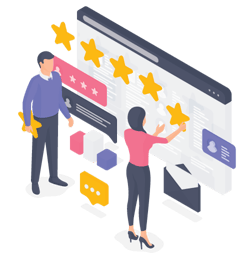 Success in manufacturing relies on the ability of the product team to create products that resonate with the consumer. Traditionally, companies have focused on product-centric goals, investing heavily to identify products and features that meet the customer's needs.
Success in manufacturing relies on the ability of the product team to create products that resonate with the consumer. Traditionally, companies have focused on product-centric goals, investing heavily to identify products and features that meet the customer's needs.
While product-centric goals remain essential, companies should broaden their focus to include a wider range of objectives that go beyond revenue targets and market share; to become sustainable, they must consider a more diverse set of goals.
Traditional Product-Centric Goals
Creating a successful product takes significant time and financial investment, making it crucial to address sustainability during the ideation stage. However, with traditional product-centric goals, a product manager will generally focus their long-term product strategy on the following:
- Are we incorporating the latest technology so our product doesn't become obsolete quickly?
- How can we ensure the product is still relevant to the consumer in the future?
- What future updates can be developed to bring value to the consumer?
Addressing these questions is key to ensuring customer satisfaction and prompts the product manager to look for opportunities for innovation when building their product.
Embracing a More Holistic Approach to Company Goals
 Today's consumers are placing a greater emphasis on the values and beliefs of the companies they support. This includes environmental considerations, equal opportunity, and fair treatment of workers in factories. Social media has heightened the awareness of these issues, and any major controversies may result in a negative response from the consumer.
Today's consumers are placing a greater emphasis on the values and beliefs of the companies they support. This includes environmental considerations, equal opportunity, and fair treatment of workers in factories. Social media has heightened the awareness of these issues, and any major controversies may result in a negative response from the consumer.
When expanding a company's objectives beyond the product, it is important for a product manager to consider the larger ecosystem, balance product-centric and customer-centric goals, and take into account the social and environmental impact of their operations.
What Is Corporate Sustainability?
Corporate sustainability refers to the idea that a company can meet its present economic needs while working to safeguard the planet. By taking a proactive stance, companies can find ways to operate more efficiently while still maintaining growth at minimal damage to the environment.
When it comes to sustainable product manufacturing, there are a few practices to keep in mind. Sourcing renewable materials can be a great way to ensure products are eco-friendly while using low-carbon or carbon-free production practices can help to reduce your company's carbon footprint.
How Are Companies Working Towards Achieving Sustainability?
 Sustainability has proven to be a lasting initiative and not just a buzzword in the product development world. Many companies are moving towards sustainable strategies in several different ways.
Sustainability has proven to be a lasting initiative and not just a buzzword in the product development world. Many companies are moving towards sustainable strategies in several different ways.
1. Shifting to Manufacturing Products That Produce Less Carbon
One example of how manufacturers are working to produce less carbon is automobile manufacturers that are implementing solutions to mitigate the impact of fossil fuel consumption. They're doing this by producing more electric vehicles while also introducing sustainable energy sources at their factories, such as solar and wind.
Another example is the airline industry. In response to climate change and the heavy carbon emissions within the industry, Airbus is currently developing an aircraft that produces zero emissions, with the ambitious goal of unveiling the world's first hydrogen-powered commercial aircraft.
2. Moving from Fossil Fuels to Renewable Energy
Unilever sells consumer goods to over 2.5 billion people every day. As part of their Climate Transition Action Plan, they are working towards switching to 100% renewable energy, with a goal to be carbon-positive by 2030.
In order to reach such ambitious targets, companies must invest heavily in energy efficiency programs and find ways to reduce their carbon emissions across the board.
3. Optimizing Products For Increased Efficiency
The world's largest shipping container company, Maersk, has set the goal to achieve carbon neutrality by 2050. The company is developing carbon-neutral vessels to roll out by 2030 and is already replacing older vessels with newer ones. The newly designed vessels have optimized hull dimensions and propulsion systems to enhance the ship's efficiency.
The Importance of Measuring Your Sustainability Goals
 With increasing consumer concern over sustainability, companies need to establish specific and achievable targets within a specified time frame to support their eco-friendly efforts. Integrating these goals into the company culture will create a stronger sense of accountability and responsibility among team members.
With increasing consumer concern over sustainability, companies need to establish specific and achievable targets within a specified time frame to support their eco-friendly efforts. Integrating these goals into the company culture will create a stronger sense of accountability and responsibility among team members.
Benefits of Goal Setting
Setting sustainability goals enables companies to track their progress and explore new approaches to achieve them. Working towards these goals also presents an opportunity to enhance product quality, improve production efficiencies and reduce costs, all while delivering environmental benefits and improving relations with the consumer.
The Benefits of Extending Goals Beyond the Product
 By extending company goals in a broader direction and incorporating them into the product vision, the company can gain numerous benefits, including:
By extending company goals in a broader direction and incorporating them into the product vision, the company can gain numerous benefits, including:
- Enhanced customer loyalty and satisfaction
- The ability to differentiate themselves from competitors in a positive way
- Enhanced brand reputation
- Increased opportunities for growth
- Positive societal and environmental impact
- Greater operational efficiencies through cost and waste reduction
- The ability to reach new customers
These benefits help to secure long-term business viability and place the company in good standing for the future.
How to Overcome Challenges When Integrating Sustainable Practices
When integrating sustainable practices, it is essential to do so in a coordinated, integrated, and formal manner. It takes careful thought and long-term planning to set achievable business goals that the entire company can work towards.
Balance Short-Term Objectives With Long Term Goals
Sustainability planning must be approached by balancing short-term objectives with long-term goals. Often, adopting new technologies requires heavy capital investments in new equipment and infrastructure that may affect the short-term profitability of the company; however, these concessions must be weighed against the long-term benefits that will extend well into the future.
Managing Potential Conflicts and Trade-Offs
Establishing broader goals may require trade-offs and adjustments in resource allocation. This requires careful planning and decision-making. Investing in eco-friendly practices may initially inflate costs, but scenario analysis—which takes into account stakeholder interests and evaluates potential consequences—is key to making informed decisions and managing the challenges of these trade-offs. Such an approach tends to bolster brand reputation and loyalty in the long term.
Leveraging Partnerships and Collaborations
To achieve meaningful change, companies must engage with stakeholders, including product teams, suppliers, and customers. Through collaborative efforts that harness combined resources and expertise, companies can benefit from shared growth and collectively achieve sustainable and socially responsible objectives.
Incorporate Sustainability For Long-Term Success
Product managers are responsible for thinking beyond the product to ensure long-term success in manufacturing. Embracing a holistic approach to goal setting that takes into account customer needs, societal impact, and environmental sustainability can lead to innovation, growth, and a positive reputation, better positioning companies for the future.
Product roadmaps are an essential tool that guides product goal setting and planning. If you would like to learn more about how Gocious product roadmap software can help you plan for a better future, book a free demo with us.


